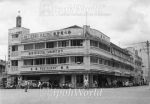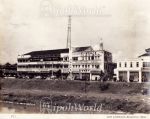We've tried to ensure the information displayed here is as accurate as possible. Should there be any inaccuracies, we would be grateful if you could let us know at info@ipohworld.org . All images and content are copyright.
(Please click on the thumbnail for a bigger image.)
The Construction And Subsequent Use Of The Lam Looking Building - Part 3.





On the left above is an end view of the building clearly showing it with its original tenants and with the F&N bottle advertisement.
In the centre and right is the building again in almost identical scenes, and showing it going into decline already and in need of maintenance. Not long after this photograph was taken the building became the Perak Emporium. The second advertising bottle from F&N can be seen at the right hand end of these two photographs.
As the Perak Emporium it was a major shopping centre from when it opened in the late 1960's until it closed in the late 1980's. It also had retail shops at street level, with smaller lots fronting an oval courtyard.
However, the business went into decline around the time that the new store "Super Kinta" opened (in the late 1980's) just along the road above the new market and that was the beginning of the death knell of this grand old building. Nonetheless the building was put back into use as the Parkson Ria shopping centre for a while and then Payless also tried to make it a success. However Super Kinta ruled the day and neither of these were long lasting endeavours.
In these later years the building deteriorated and only the small shops on the ground floor continued to survive. On December 26th 2004 the building caught fire and was completely burnt out. Said to be only fit for demolition, it was bought over and fully restored recently (2010) hopefully to shine again as a grand example of the Iversen art deco style.
The fourth photograph (which we have in our collection) shows the sign "Emporium Perak"; this is from the 1970s.
Mano refers to this image:
Ipoh Remembered adds:
The Perak Emporium opened for business in 1972, it was Ipoh’s first fully air-conditioned department store, but it was not Ipoh’s first “emporium.” There were several so-called before it, small shops on Hugh Low Street or Leech Street. A more up-market one in the 1960s was Lim Emporium on Station Road, immediately adjacent to the Straits Trading Building..
The story begins with the Lim brothers: Teen-ager Tow Seng, who came from eastern Canton to Singapore in 1935, and younger brother Tow Yong, who arrived in 1940 (after the Japanese had invaded his home-town).
In Singapore, Tow Seng soon founded his own business and when Tow Yong arrived, he joined the company. Their focus at the time was the import (from China), manufacture (in Singapore), and sale (in Singapore) of low-cost garments. (ika: By e-mail I’ve sent you an image showing an advertisement they published in the ’60s.)
In the mid-’60s, the brothers created a new entity called Emporium Holdings which immediately began building its chain of “one-stop shopping” department stores. The first one, at Raffles Place in Singapore, was called the Oriental Emporium. Growth was explosive. Within two years they had opened stores as far away as Penang, and soon they were building restaurants as well. As I said above, by 1972, they had opened an emporium in Ipoh; and three years later there was another one in Kampar.
When the Lims opened their Emporium in Ipoh’s Lam Looking Building in 1972, it occupied the ground floor and first floor. The second floor was left unused until it was needed a short time later.
In all, Emporium Holdings spent about a quarter of a million dollars on renovations before moving in.
And then there were twelve good years, but then the end came.
A severe recession in the mid-’80s brought things to a crashing halt. Emporium Holdings, now cash-poor, spent a year flailing around in vain seeking new investors. Its Singapore business was “rescued” by millionaire architect Bill Ch’ng (who quickly enough got himself into deep trouble with the law, and more than once, but that’s another story).
Whereas the Lims’ Malaysian operations were liquidated in ’87 by Peat Marwick. The price: $12 million. The value: more than ten times that (if the business were to be created anew).
And the buyer: Amalgamated Steel Mills, a division of the Cheng family’s Lion Group, eventual proprietor of the Parade, Parkson Grand and Parkson Riabrands as well as Xtra and the lower-budget Payless.
As for the Lim brothers with whom we began the story: Tow Seng died in 1991; whereas Tow Yong died just five years ago — after picking himself up out of bankruptcy, starting over in Sabah and Brunei, and making another fortune for himself and his family.
And Again:
Yes, talking about the “Perak Emporium” building. It was officially opened on the 17th of February, 1934 — and after the ceremony and speeches, there was a reception. Lam Looking and his wife were both present.
In Lam Looking’s speech he credited the firm of Keys & Dowdeswell for the design of the building. I’m almost certain your father was an employee at the time. Was he still the head of the firm’s Ipoh office?
And in his papers does it say who the building contractor was? I know it was a local Chinese towkay — but for the life of me I can’t seem to retrieve his name. Perhaps you can!
The fifth photograph is also of the Lam Looking building - when it was Parkson Ria. This picture, from the book "Perak - An Inside Look of the State's Historical Development", was taken in the early 1990s.
To go to Part 1, click here.
To see a similar view of the building from Hugh Low Bridge, click here.
To see a similar panoramic view of the building from across the Kinta River, click here.
To see a closer view of the front of the building, click here.
To see a scan of a complimentary diary from the Perak Emporium, click here.